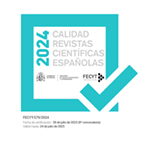Riesgos de la comunicación de riesgo: un modelo discursivo para la comunicación de riesgo en emergencias
Resumen
Con el marco de referencia que ha supuesto la experiencia comunicativa impuesta por la pandemia COVID-19, el artículo aborda cuáles son las especificidades de la comunicación de riesgo y la comunicación de crisis, con especial atención a las situaciones denominadas «de comunicación de riesgo en emergencias» (CRE); se revisan igualmente, desde la óptica discursiva, los modelos teóricos más desarrollados en este ámbito, de bases psicologistas y de teoría de la comunicación. A partir de este estado de la cuestión se propone un modelo específicamente lingüístico / discursivo de la comunicación de riesgo, susceptible de ser considerado como un área definida de la pragmática aplicada. Tal modelo se despliega en dos niveles: el que tiene en cuenta las estrategias discursivas encargadas del encuadre textual (léxico, sintaxis, ilocutividad, informatividad y dialogismo) y el que define la posición enunciativa desde la que se construye el mensaje (transparencia, planificación, disposición ante los receptores). Las categorías y funciones de los dos niveles se presentan mediante ejemplos concretos referidos a la gestión de la pandemia del SARS-CoV-2, cuya revisión ordenada permite identificar en cada caso algunos errores y opciones desafortunadas que constituyen verdaderos «riesgos de la comunicación de riesgo».
Descargas
Descarga artículo
Licencia
La revista Círculo de Lingüística Aplicada a la Comunicación, para fomentar el intercambio global del conocimiento, facilita el acceso sin restricciones a sus contenidos desde el momento de su publicación en la presente edición electrónica, y por eso es una revista de acceso abierto. Los originales publicados en esta revista son propiedad de la Universidad Complutense de Madrid y es obligatorio citar su procedencia en cualquier reproducción total o parcial. Todos los contenidos se distribuyen bajo una licencia de uso y distribución Creative Commons Reconocimiento 4.0 (CC BY 4.0). Esta circunstancia ha de hacerse constar expresamente de esta forma cuando sea necesario. Puede consultar la versión informativa y el texto legal de la licencia.











